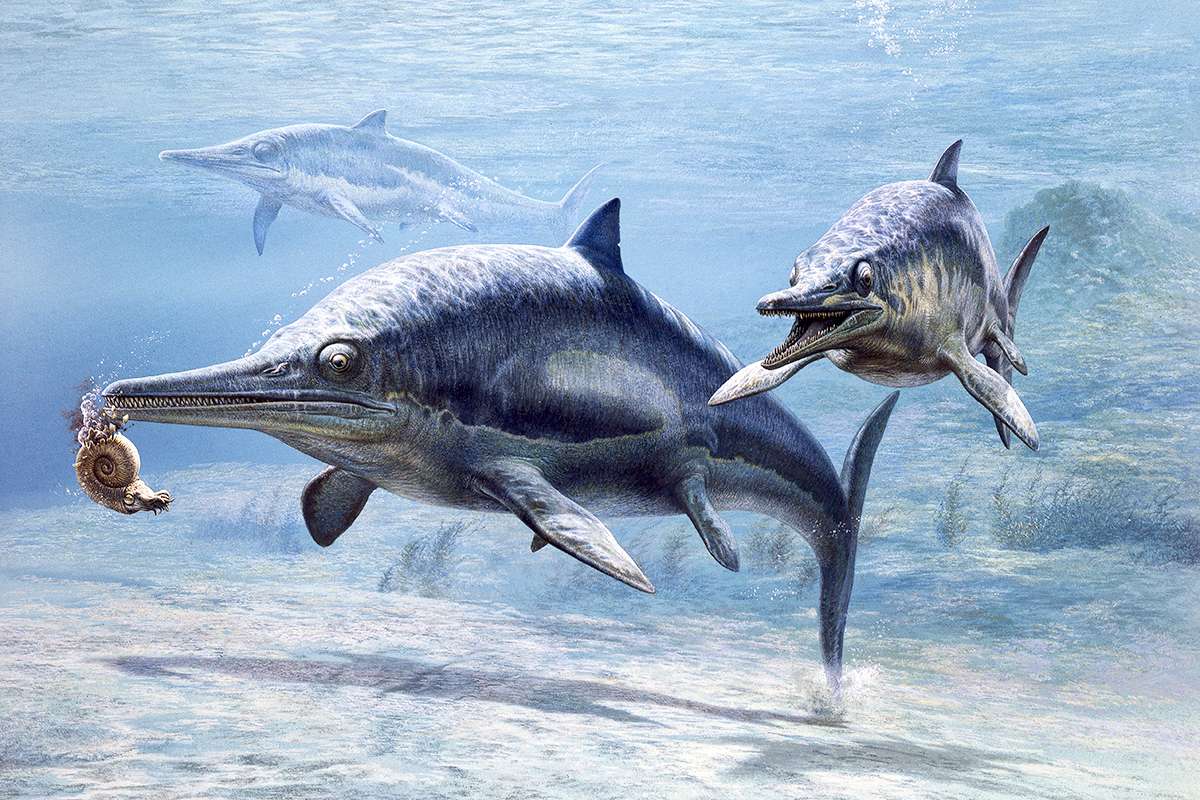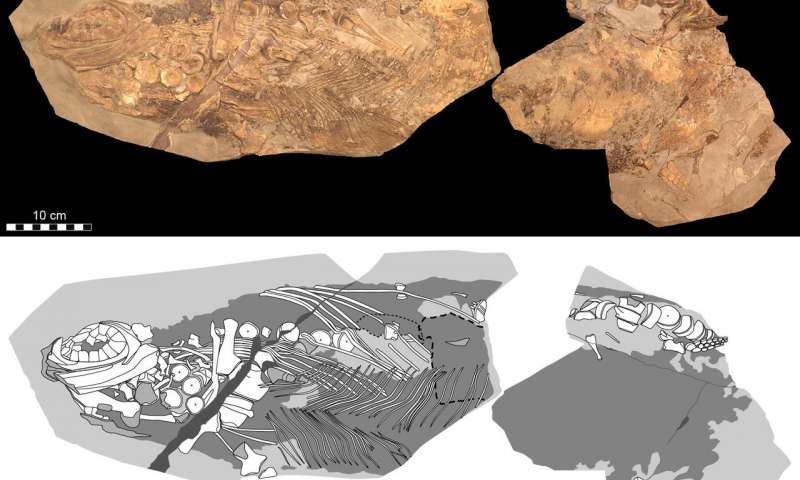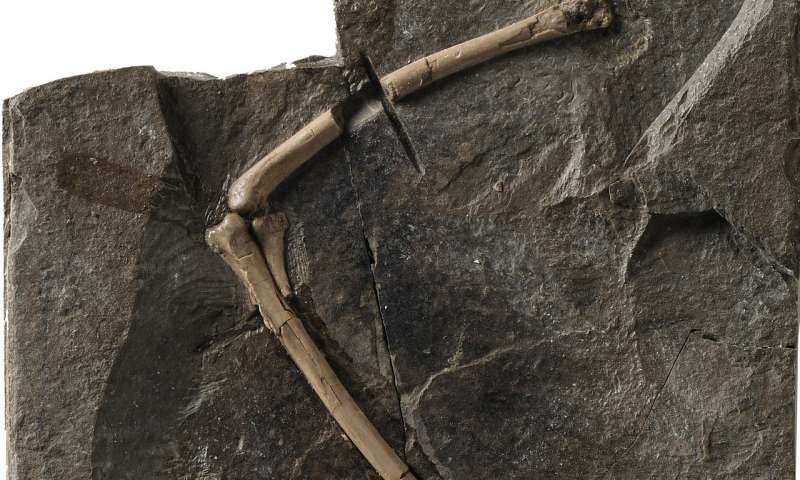At https://phys.org/print463211497.html … concerns the discovery of the soft parts of an ichthyosaur from the Jurassic period. Also the subject of a post at New Scientist – see https://www.newscientist.com/article/2187399-fossil-blubber-shows-ichthy… … and Robert has also provided a link to a young earth site at https://crev.info/2018/12/two-soft-tissue-fossils-pile-evidence-deep-time/ … which is really pushing the idea that because soft tissue has survived the fossils themselves must be relatively young. In this case, perishing in the Biblical Flood. Basically, the discovery of soft tissue is the subject of the study and of the critique at the last link. Does the finding of blubber on a specimen of Ichthyosaur infer it is a mammal rather than a reptile. Is there such a thing as a warm blooded reptile – or is that straining the evidence. In a scenario which involves catastrophism, and therefore punctuated evolution, there is no reason why dolphins came along after the K/T boundary and filled a niche vacated by Ichthyosaurs. The idea Ichthyosaurs were mammals is an interesting idea as dinosaur age mammals are thought to be mouse size, or even more dimunitive. Could mammalian traits have developed in marine animals of the Jurassic seas?
 … Ichthyosaurs are believed to be aquatic reptiles. This new discovery shows our understanding of fossilised animals may not be as accurate as we might like. The discovery of a Jurassic period Ichthyosaur in Germany is not particularly surprising – but after analysis of its remains soft tissue was found. There is a lovely example of the skeleton of an Ichthyosaur skeleton in Milton Keynes library, salvaged from a lake (now a recreation facility). The Steve Etches museum at Kimmeridge Bay has some nice fossils of both Pleisosaurs and Ichthyosaurs.
… Ichthyosaurs are believed to be aquatic reptiles. This new discovery shows our understanding of fossilised animals may not be as accurate as we might like. The discovery of a Jurassic period Ichthyosaur in Germany is not particularly surprising – but after analysis of its remains soft tissue was found. There is a lovely example of the skeleton of an Ichthyosaur skeleton in Milton Keynes library, salvaged from a lake (now a recreation facility). The Steve Etches museum at Kimmeridge Bay has some nice fossils of both Pleisosaurs and Ichthyosaurs.
 …. Cells, cellular organelles and original biomolecules have been discovered in preserved soft parts of an Icthyosaur – a name that literally means, fish lizard, a dolphin like marine reptile. It had all the abilities of a modern dolphin – agile and hunting in packs for smaller fish species etc. The were most likely warm blooded it has been decided and had insulating blubber and used colouration as camouflage from predators (such as the pleisosaurs). Ichthyosaurs have been of interest to paleontologists for many years as they resemble dolphins in many ways – either though apparently not closely related to them. Mary Schweitzer, professor of biological sciences, admits they aren't too sure of the biology as they have features in common with living marine reptiles such as sea turtles. Fossils seem to show they gave live birth, in contrast to most reptiles that gave birth to eggs (which required hatching). In addition they do not seem to have had a scaly skin as in the majority of reptiles, somewhat akin to leatherback turtles. Losing scales seems to have allowed greater maneuverability (in water).
…. Cells, cellular organelles and original biomolecules have been discovered in preserved soft parts of an Icthyosaur – a name that literally means, fish lizard, a dolphin like marine reptile. It had all the abilities of a modern dolphin – agile and hunting in packs for smaller fish species etc. The were most likely warm blooded it has been decided and had insulating blubber and used colouration as camouflage from predators (such as the pleisosaurs). Ichthyosaurs have been of interest to paleontologists for many years as they resemble dolphins in many ways – either though apparently not closely related to them. Mary Schweitzer, professor of biological sciences, admits they aren't too sure of the biology as they have features in common with living marine reptiles such as sea turtles. Fossils seem to show they gave live birth, in contrast to most reptiles that gave birth to eggs (which required hatching). In addition they do not seem to have had a scaly skin as in the majority of reptiles, somewhat akin to leatherback turtles. Losing scales seems to have allowed greater maneuverability (in water).
The article at https://crev.info goes on to mention a second discovery of soft tissue – this time in Jurassic birds. The medillary bone is the feature of another post, at https://phys.org/print463226490.html …. a medillary bone found on an Enanthionithine (a proto bird species) was discovered in China and the results are published in Nature Communications (December 5th 2019) …
 … the medullary bone is a bone tissue unique to modern birds – until now. It is present in females about to lay eggs and forms in empty spaces in the skeleton. It is a reservoir for calcium which is used by the birds to create egg shell. We now know that medullary bones occur in non-avian dinosaurs, even in Tyrannosauros Rex. This tissue seems to link dinosaurs with birds, hence the current rash of quips by museum staff and paleontologists. Medullary bones might have been an avian feature inherent in some dinosaurs and evolved in the hollow bones (on birds) which lightened the skeleton for flight. It s also specualted that other kinds of dinosaur had similar bone structure – even if only to allow them to blunder around the landscape.
… the medullary bone is a bone tissue unique to modern birds – until now. It is present in females about to lay eggs and forms in empty spaces in the skeleton. It is a reservoir for calcium which is used by the birds to create egg shell. We now know that medullary bones occur in non-avian dinosaurs, even in Tyrannosauros Rex. This tissue seems to link dinosaurs with birds, hence the current rash of quips by museum staff and paleontologists. Medullary bones might have been an avian feature inherent in some dinosaurs and evolved in the hollow bones (on birds) which lightened the skeleton for flight. It s also specualted that other kinds of dinosaur had similar bone structure – even if only to allow them to blunder around the landscape.
